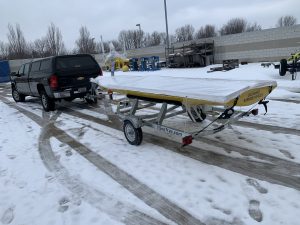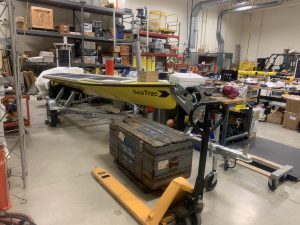Image by SeaTrac Systems
In January, a trailer pulled up to the NOAA Great Lakes Environmental Research Lab (GLERL), passed the existing fleet of buoys, sensors, and other gear, and unloaded a new kind of observing platform. Capable of patrolling the shallow waters of Maumee Bay in western Lake Erie, researchers will use the SeaTrac Autonomous Surface Vehicle (ASV) to monitor the most toxic area of the western Lake Erie harmful algal bloom (HAB).
- In 2014, the HAB that temporarily shut down the city of Toledo’s water supply began in the warm, shallow waters of Maumee Bay. Yearly HABs have become a regular part of the summer and fall for those living near the western shores of Lake Erie.
- Knowing whether the green algae scum floating in the bay is toxic from hour to hour is critical for making informed decisions about beach closures, water treatment, and more.
- Typically, this area is monitored by researchers and technicians who use satellite and aerial imagery, live water quality data from a network of sensors, and hand-collected water samples.
- The only way to know, for sure, if the bloom is toxic from hour to hour is to sample the water.
In order to more fully understand the quickly changing HAB, researchers can use all the data they can get, but current monitoring methods have limitations. Clouds sometimes block a satellite’s view of the bloom, sampling trips can only gather and process samples every day or two, and existing in-water sensors can only capture data from one point in the lake, creating gaps in the data.
The SeaTrac arrived at GLERL in winter of 2020.
That’s why, when supporting funds became available through GLOS, GLERL researchers Steve Ruberg and Reagan Errera were eager to buy the SeaTrac and get it ready for its first test mission on the lake.
- Resembling a small sailboat, but missing a sail, the SeaTrac is covered in solar panels that can, theoretically, power the electric motor and onboard sensors indefinitely, enabling it to navigate the bay, making many decisions for itself, and collecting data for the entire HABs season.
- The main instrument onboard, an environmental sample processor (ESP), will continuously collect water samples, preserve samples for later DNA analysis, and determine whether the bloom is toxic at that location.
- Researchers also hope to eventually add a device called a fluoroprobe that, by analyzing light refracted through water samples, can identify the type of algae, spotting potentially toxic Microcystis. “In June, you could have a sizable area of diatoms and then along shore where the water’s warmer, that can transition into Microcystis,” says Ruberg. “A vehicle like this can help us map potentially toxic areas, even on days when research vessels are docked because the waves are too big.”
The team at GLERL is prepping the SeaTrac for short test missions in Maumee Bay this summer. Photos by Kyle Beadle.
Throughout the Great Lakes, researchers use other uncrewed systems like underwater or wave gliders to perform similar autonomous monitoring, but for Maumee Bay, the SeaTrac was best suited.
- The SeaTrac’s onboard electric motor makes it far more maneuverable.
- Requiring less than a meter of water, it can operate in the shallower HABs laden locations of the bay that researchers cannot currently sample.
- Since it is a new type of platform, engineers like Kyle Beadle will be using the coming months to better understand the vessel. “This year is going to be about learning how to use the thing and setting up a collision avoidance system so that it can operate in the shallow sections without having any issues with fishing vessels,” says Beadle.
- Because the SeaTrac is small and moves slowly, there is little risk to other vessels. Beadle says he’s more concerned with other boats colliding with it.
In coming years, researchers hope to have data on bloom toxicity, algae type, and more transmitted to them 24-hours per day.
- The system should be able to create a map of the Maumee Bay bloom once a day.
- When the system is fully functional, it will do the work of a four-person crew collecting water samples all day and night, and sending toxicity data every 2-3 hours.
- The first usable data isn’t expected until 2022, but this summer, researchers will be testing the device in the lab and on short half or full-day missions.
In the future, data will be made available through GLERL and on GLOS’ Seagull platform.

